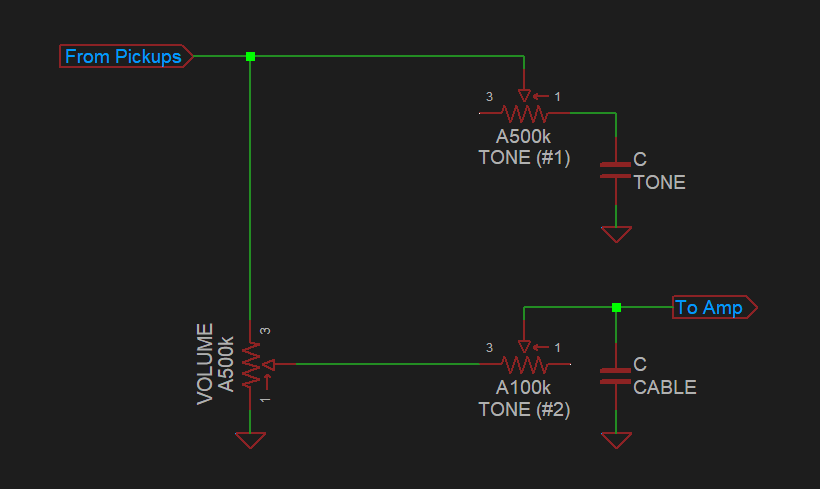Post by Yogi B on Jul 23, 2020 9:53:05 GMT -5
Often cable capacitance can be seen as an elusive ne'er-do-well, stealing our precious treble on its journey from guitar to amp, especially if we have the audacity to decide to roll down our volume controls.
However, what if our goal is to roll off treble, as with a regular tone control?
For about the first half of the rotation (10 down to 5) a standard tone control is not really adding a parallel branch (the tone capacitor) of a new capacitive LPF, but rather reducing the parallel branch of the already existing inductive LPF formed by the pickup(s)'s inductance and the potentiometers resistance. The trouble is that the cut-off frequency of this (1st order) LPF is for the most part above that of the (2nd order) LPF caused the pickup(s)'s inductance and our old foe cable capacitance, so there is little evident treble roll off over most of this range.
My idea is a simple one, what if instead of trying to reduce treble by only introducing a new LPF, we also modify that pre-existing LPF that is (in part) due to cable capacitance?
The simplest way we can achieve this is by adding series resistance between the volume control and the output jack, something like this: I chose 100k as the value for the second potentiometer gang as it should be large enough to make a noticeable difference in cut-off frequency at around ten to twenty times the resistance of a typical pickup (and roughly equal the maximum output impedance of a 500k volume control, at 125k), but also it should be small enough that it doesn't cause too large a reduction in volume considering the typical 1Meg input impedance of the following amp/stompbox/interface.
I chose 100k as the value for the second potentiometer gang as it should be large enough to make a noticeable difference in cut-off frequency at around ten to twenty times the resistance of a typical pickup (and roughly equal the maximum output impedance of a 500k volume control, at 125k), but also it should be small enough that it doesn't cause too large a reduction in volume considering the typical 1Meg input impedance of the following amp/stompbox/interface.
A Log taper pot is specified such that the majority of the additional resistance is introduced within the first half of rotation (10 down to 5), i.e. where the regular tone control needs the most help in order to actually cut treble.
As an alternative to a 100k logarithmic element, a 500k linear element could be used in parallel with a 120k resistor to give similar results. Or if you wish to experiment further, that parallel resistor could be replaced with a trimmer. This would allow changing the taper/maximum resistance, in addition to providing a way to return to the standard tone control behaviour by setting the trimmer to zero ohms, thereby shorting the second gang.
There are two issues I can anticipate:
However, what if our goal is to roll off treble, as with a regular tone control?
For about the first half of the rotation (10 down to 5) a standard tone control is not really adding a parallel branch (the tone capacitor) of a new capacitive LPF, but rather reducing the parallel branch of the already existing inductive LPF formed by the pickup(s)'s inductance and the potentiometers resistance. The trouble is that the cut-off frequency of this (1st order) LPF is for the most part above that of the (2nd order) LPF caused the pickup(s)'s inductance and our old foe cable capacitance, so there is little evident treble roll off over most of this range.
My idea is a simple one, what if instead of trying to reduce treble by only introducing a new LPF, we also modify that pre-existing LPF that is (in part) due to cable capacitance?
The simplest way we can achieve this is by adding series resistance between the volume control and the output jack, something like this:

A Log taper pot is specified such that the majority of the additional resistance is introduced within the first half of rotation (10 down to 5), i.e. where the regular tone control needs the most help in order to actually cut treble.
As an alternative to a 100k logarithmic element, a 500k linear element could be used in parallel with a 120k resistor to give similar results. Or if you wish to experiment further, that parallel resistor could be replaced with a trimmer. This would allow changing the taper/maximum resistance, in addition to providing a way to return to the standard tone control behaviour by setting the trimmer to zero ohms, thereby shorting the second gang.
There are two issues I can anticipate:
- firstly this may well upset certain fuzz pedals with low input impedance;
- and secondly because of the location of the additional resistance when both the volume and tone controls are at zero, the tip of the output jack will no longer be directly grounded -- instead it is left floating 100k above ground, meaning it will likely be susceptible to quite a bit of stray noise, shielding notwithstanding.









